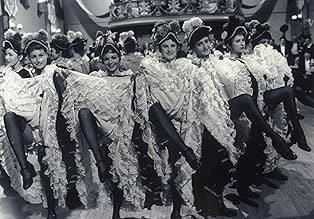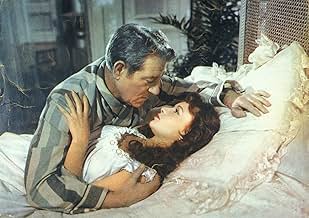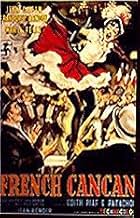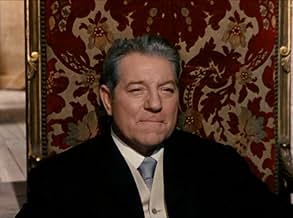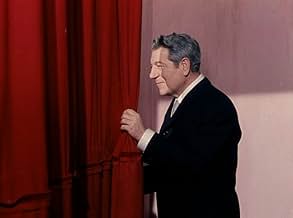French Cancan
- 1955
- Tous publics
- 1h 42m
IMDb RATING
7.3/10
4.7K
YOUR RATING
This comedy drama from Jean Renoir chronicles the revival of Paris' most notorious dance as it tells the story of a theater producer who turns a humble washerwoman into a star at the Moulin ... Read allThis comedy drama from Jean Renoir chronicles the revival of Paris' most notorious dance as it tells the story of a theater producer who turns a humble washerwoman into a star at the Moulin Rouge.This comedy drama from Jean Renoir chronicles the revival of Paris' most notorious dance as it tells the story of a theater producer who turns a humble washerwoman into a star at the Moulin Rouge.
- Director
- Writers
- All cast & crew
- Production, box office & more at IMDbPro
Featured reviews
Of the several Jean Renoir films I have seen, this was by far the most interesting.
This film was obviously the inspiration for the Baz Luhrman film Moulin Rouge. Luhrman even appropriated one of the original songs for use in his film.
The film tells the story of the construction of the Moulin Rouge for the presentation of a revival of the CanCan. Although characterization is a bit weak and most characters are little more than stereotypes, the plot, music, action, and spectacular visuals more than make up for the shortcomings.
This is a loving tribute to the Paris of the impressionist period and is filmed beautifully in color.
Does anyone know if there is any truth to the tale?
This film was obviously the inspiration for the Baz Luhrman film Moulin Rouge. Luhrman even appropriated one of the original songs for use in his film.
The film tells the story of the construction of the Moulin Rouge for the presentation of a revival of the CanCan. Although characterization is a bit weak and most characters are little more than stereotypes, the plot, music, action, and spectacular visuals more than make up for the shortcomings.
This is a loving tribute to the Paris of the impressionist period and is filmed beautifully in color.
Does anyone know if there is any truth to the tale?
The story is simple but the execution is marvelous. A Belle Epoque impresario, down on his financial luck, is going to open a new club, the Moulin Rouge, with a new dance, the French cancan. He encounters a working girl and makes her a dancer. She'll become a star. There are several crises to overcome before that happens.
The movie is Jean Renoir's tribute to show business, and he puts it on the screen with color, verve, humor, and humanity. There are wonderful performances by all the actors. The leads are Jean Gabin as Henri Danglard, the impresario; Francoise Arnoul as Nini, the girl who'll become a star; and Maria Felix as Lola de Castro, an overwhelmingly tempestuous beauty and Danglard's lover at the start. Gabin exudes confidence, worldly humor and dedication to show business. He even dances a bit. Arnoul is first rate, too. It looks like she was doing her own dances, and as an actress think of a young Leslie Caron with brains and charm.
The climax of the movie is the opening of the club, with Felix's star dance, comic songs, a whistler, a Danglar-discovered singer, all moving toward the introduction of the French cancan. The crises happen and are resolved. Then the cancan explodes. Dancing girls come bursting out from the stage, the front of the theater, through posters, down ropes from the balcony. The house swirls with the black tie and tails of the swells and the garish colors of the dancers' gowns. The cancan number lasts probably ten or fifteen minutes or so, all music and gaiety, all high kicks and splits. It's amazing when row after row of the dancers, moving toward the camera through the audience, leap up, legs extended straight forward and backward, backs arched, then land on the dance floor in full splits. I didn't know whether to shout or wince.
The last scene of the movie is outside the club, shot from the cobblestone street looking at the entrance. It's a medium shot and from the side street a happy, inebriated fellow in black tie and top hat staggers across, pauses to tip his hat at the camera, then staggers off. A completely charming ending.
This really is a marvelous movie.
The movie is Jean Renoir's tribute to show business, and he puts it on the screen with color, verve, humor, and humanity. There are wonderful performances by all the actors. The leads are Jean Gabin as Henri Danglard, the impresario; Francoise Arnoul as Nini, the girl who'll become a star; and Maria Felix as Lola de Castro, an overwhelmingly tempestuous beauty and Danglard's lover at the start. Gabin exudes confidence, worldly humor and dedication to show business. He even dances a bit. Arnoul is first rate, too. It looks like she was doing her own dances, and as an actress think of a young Leslie Caron with brains and charm.
The climax of the movie is the opening of the club, with Felix's star dance, comic songs, a whistler, a Danglar-discovered singer, all moving toward the introduction of the French cancan. The crises happen and are resolved. Then the cancan explodes. Dancing girls come bursting out from the stage, the front of the theater, through posters, down ropes from the balcony. The house swirls with the black tie and tails of the swells and the garish colors of the dancers' gowns. The cancan number lasts probably ten or fifteen minutes or so, all music and gaiety, all high kicks and splits. It's amazing when row after row of the dancers, moving toward the camera through the audience, leap up, legs extended straight forward and backward, backs arched, then land on the dance floor in full splits. I didn't know whether to shout or wince.
The last scene of the movie is outside the club, shot from the cobblestone street looking at the entrance. It's a medium shot and from the side street a happy, inebriated fellow in black tie and top hat staggers across, pauses to tip his hat at the camera, then staggers off. A completely charming ending.
This really is a marvelous movie.
Although it doesn't seem very promising for a long stretch, Renoir's French Cancan ends up being an effortlessly charming film. The story is cliché: a laundry girl, Nini (Françoise Arnoul), is discovered by a night club owner, Danglard (Jean Gabin). Danglard steals her from her baker boyfriend and drops his current girlfriend, both of whom come back for their former lovers. Nini has to choose whether to go back to her humble life with the baker, go on with the show with her employer, oh, or become a princess, as a prince falls in love with her at one point, too. I'm glad the film didn't go for the most obvious choice, as a lesser film certainly would have. The film ends with the opening of Danglard's new night club, the Moulin Rouge, and a couple of gorgeous song and dance numbers. The first of them, "Complainte de la Butte," which also provides the base of most of the film's musical score, is simply one of the most gorgeous songs ever written, and Renoir himself wrote it. If you're a fan of Baz Luhrmann's 2001 film Moulin Rouge!, you'll recognize the tune, as it comes up near the beginning of that film, sung by Rufus Wainwright. Although it isn't very prominent in that film, everyone I know who owns the soundtrack loves it. In addition to having one of the most lovely songs ever written, French Cancan also boasts one of the cutest leading ladies ever to grace the screen. It's hard not to fall head-over-heels in love with that girl. 8/10.
I watched this movie three times at different ages of my life and always did enjoy it very much indeed. This Can-Can is an authentic explosion of joie de vivre, like Stanley Donen and Gene Kelly musical, but in French way. And a Jean Renoir nice tribute to his time, his friends, lovers, music and dances. It is at same time a show business chronicle of that age, full of affection and French mood. It is too a clear tribute to the Impressionism (people who likes impressionistic painters will like this picture). It is particularly a tribute to Toulouse-Lautrec and, of course, to Jean Renoir father, Pierre-Auguste. You will find hear a trustworthy and splendid colored recreation of some Renoir master work. Excellent casting, scenery, sound-effects and music. Even it tell us about the creation of Parisian Moulin Rouge, obviously it is a fiction story (and not very original by the way, as it fall down in the very well know moral that the show must go on). But the Jean Renoir production is great.
I would give this evocation of the early Moulin Rouge a high rating for the final fifteen minutes alone, a dazzling recreation of what might have been the riotous presentation of the French Cancan during the Belle Epoque, all color and noise and organized mayhem.
This is an old-fashioned film about a theatrical entrepreneur who turns working girls into stars--one at a time. Likable roué Jean Gabin plays Danglar with great aplomb, and having worked in the theatre myself, recognize the fine backstage moment in the film where the creator does not hurry to see his final creation; it is a quiet, subtle moment, and like much in the film, can be lost in the build-up to the opening of France's most famous dance hall; the color is mint Technicolor, the acting spot on, and, while old-fashioned, the film is a lovely evocation of an imagined past.
This is an old-fashioned film about a theatrical entrepreneur who turns working girls into stars--one at a time. Likable roué Jean Gabin plays Danglar with great aplomb, and having worked in the theatre myself, recognize the fine backstage moment in the film where the creator does not hurry to see his final creation; it is a quiet, subtle moment, and like much in the film, can be lost in the build-up to the opening of France's most famous dance hall; the color is mint Technicolor, the acting spot on, and, while old-fashioned, the film is a lovely evocation of an imagined past.
Did you know
- TriviaThe on-screen singer of "La complainte de la Butte" is not Cora Vaucaire (credited in the titles) as she was deemed not good-looking enough to appear on film, so Italian actress Anna Amendola was put in front of the camera and mimed to the song...
- Quotes
Henri Danglard: Do I look like Prince Charming? Only one thing matters to me - what I create.
- Alternate versionsOriginally released in the US in 1956 at 93 minutes; ten minutes of footage removed from the original French version were reinstated for 1985 reissue.
- ConnectionsFeatured in Voyage à travers le cinéma français (2016)
- How long is French Cancan?Powered by Alexa
Details
Box office
- Gross worldwide
- $10,799
- Runtime1 hour 42 minutes
- Color
Contribute to this page
Suggest an edit or add missing content


![Watch Bande-annonce [VO]](https://m.media-amazon.com/images/M/MV5BMDIzNTViZDUtMTQ0MC00MDExLWFkNzYtNjJhMDlkN2YzMDRjXkEyXkFqcGdeQXRyYW5zY29kZS13b3JrZmxvdw@@._V1_QL75_UX500_CR0)
